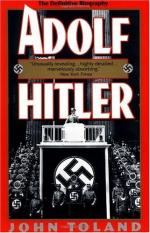|
This section contains 1,089 words (approx. 4 pages at 300 words per page) |

|
The Rise of Hitler and the Nazi Party
Summary: Explore the Rise of Hitler and the Nazi party. Traces the roots of facism to the economic and political problems faced by Germany after World War I. Examines the lasting effects of political instability, the treaty of Versailles and the depression.
In 1919, when World War 1 ended, Germany was faced with many economic and political problems. From 1919-1923, Germany had a chain of attempted revolutions. Communists tried to get Germany to be a communist country like Russia, while nationalists tried to cause the downfall of the government. The German population was very harsh with the government for accepting to the terms in the treaty of Versailles. Adolf Hitler, who was a soldier in the first World War, joined the German Workers Party. This party was an Anti-Semitism party led by Anton Drexler and in 1921 Hitler was the leader of this party. Political instability, the treaty of Versailles and the depression were 3 key factors that led to the rise of Hitler and the Nazi party. "'
When Germany surrendered to the allies in World War One, Germany had to sign the treaty of Versailles. This treaty stated that Germany had to...
|
This section contains 1,089 words (approx. 4 pages at 300 words per page) |

|


